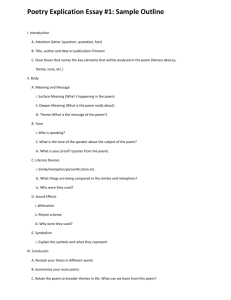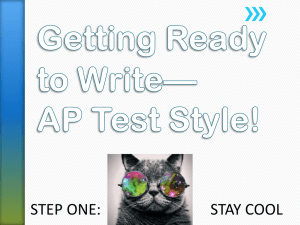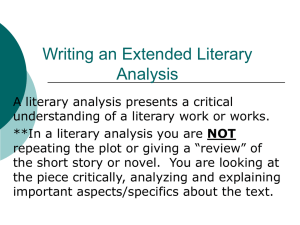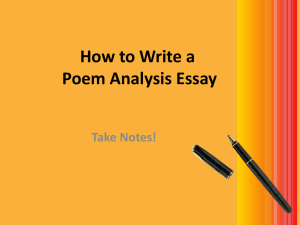9th Grade Literary Analysis
advertisement
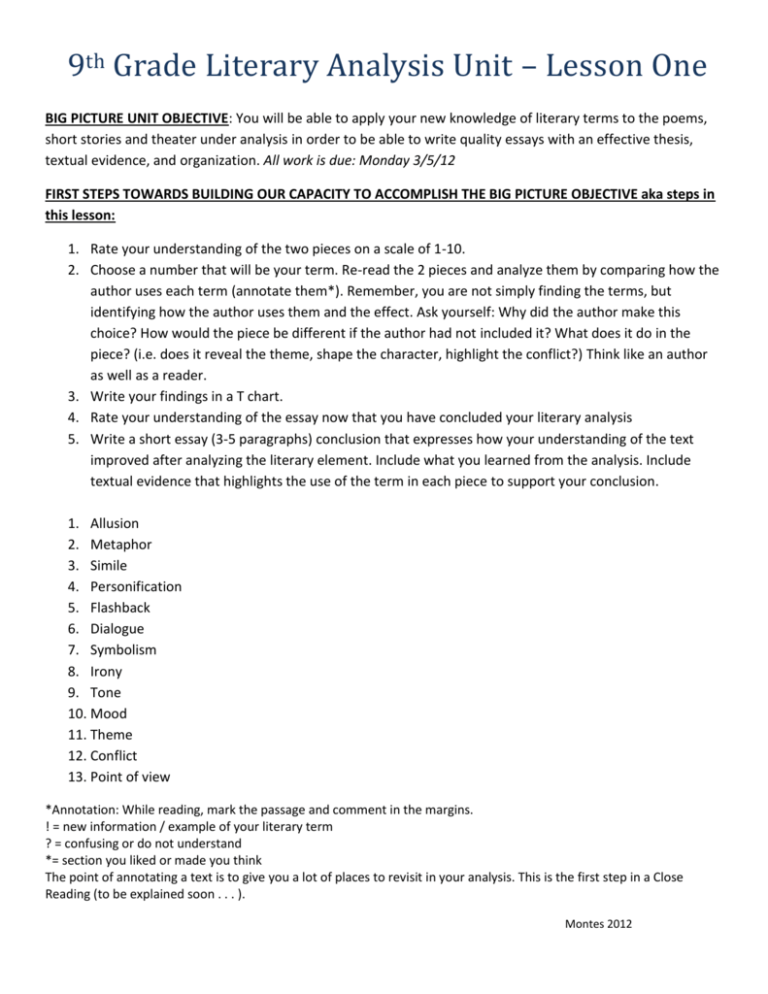
9th Grade Literary Analysis Unit – Lesson One BIG PICTURE UNIT OBJECTIVE: You will be able to apply your new knowledge of literary terms to the poems, short stories and theater under analysis in order to be able to write quality essays with an effective thesis, textual evidence, and organization. All work is due: Monday 3/5/12 FIRST STEPS TOWARDS BUILDING OUR CAPACITY TO ACCOMPLISH THE BIG PICTURE OBJECTIVE aka steps in this lesson: 1. Rate your understanding of the two pieces on a scale of 1-10. 2. Choose a number that will be your term. Re-read the 2 pieces and analyze them by comparing how the author uses each term (annotate them*). Remember, you are not simply finding the terms, but identifying how the author uses them and the effect. Ask yourself: Why did the author make this choice? How would the piece be different if the author had not included it? What does it do in the piece? (i.e. does it reveal the theme, shape the character, highlight the conflict?) Think like an author as well as a reader. 3. Write your findings in a T chart. 4. Rate your understanding of the essay now that you have concluded your literary analysis 5. Write a short essay (3-5 paragraphs) conclusion that expresses how your understanding of the text improved after analyzing the literary element. Include what you learned from the analysis. Include textual evidence that highlights the use of the term in each piece to support your conclusion. 1. Allusion 2. Metaphor 3. Simile 4. Personification 5. Flashback 6. Dialogue 7. Symbolism 8. Irony 9. Tone 10. Mood 11. Theme 12. Conflict 13. Point of view *Annotation: While reading, mark the passage and comment in the margins. ! = new information / example of your literary term ? = confusing or do not understand *= section you liked or made you think The point of annotating a text is to give you a lot of places to revisit in your analysis. This is the first step in a Close Reading (to be explained soon . . . ). Montes 2012 STANDARDS: Writing applications: 2.2 Write responses to literature: a. Demonstrate a comprehensive grasp of the significant ideas of literary works. b. Support important ideas and viewpoints through accurate and detailed references to the text or to other works. c. Demonstrate awareness of the author’s use of stylistic devices and an appreciation of the effects created. d. Identify and assess the impact of perceived ambiguities, nuances, and complexities within the text. Reading: Structural Features of Literature 3.1 Articulate the relationship between the expressed purposes and the characteristics of different forms of dramatic literature (e.g., comedy, tragedy, drama, dramatic monologue). 3.2 Compare and contrast the presentation of a similar theme or topic across genres to explain how the selection of genre shapes the theme or topic. 3.3 Analyze interactions between main and subordinate characters in a literary text (e.g., internal and external conflicts, motivations, relationships, influences) and explain the way those interactions affect the plot. 3.4 Determine characters’ traits by what the characters say about themselves in narration, dialogue, dramatic monologue, and soliloquy. 3.5 Compare works that express a universal theme and provide evidence to support the ideas expressed in each work. 3.6 Analyze and trace an author’s development of time and sequence, including the use of complex literary devices (e.g., foreshadowing, flashbacks). 3.7 Recognize and understand the significance of various literary devices, including figurative language, imagery, allegory, and symbolism, and explain their appeal. 3.8 Interpret and evaluate the impact of ambiguities, subtleties, contradictions, ironies, and incongruities in a text. 3.9 Explain how voice, persona, and the choice of a narrator affect characterization and the tone, plot, and credibility of a text. 3.10 Identify and describe the function of dialogue, scene designs, soliloquies, asides, and character foils in dramatic literature. Literary Criticism 3.11 Evaluate the aesthetic qualities of style, including the impact of diction and figurative language on tone, mood, and theme, using the terminology of literary criticism. Montes 2012 9th Grade Literary Analysis Unit – Lesson Two BIG PICTURE UNIT OBJECTIVE: You will be able to apply your new knowledge of literary terms to the poems, short stories and theater under analysis in order to be able to write quality essays with an effective thesis, textual evidence, and organization. NEXT STEPS TOWARDS BUILDING OUR CAPACITY TO ACCOMPLISH THE BIG PICTURE OBJECTIVE aka steps in this lesson: (reminder: 1 = no understanding & 10 = you are in the author’s head) 1. 2. 3. 4. 5. Rate your understanding of the poem on a scale of 1-10 after your first silently read. ________ Rate your understanding of the poem on a scale of 1-10 after listening to the poem read aloud. ______ Annotate the poem (see reminders below) Rate your understanding of the poems after annotating them and the class discussion. _________ Create a T chart where you pull out literary elements and analyze the effect on the listener: Literary Element Effect on the reader 6. Rate your understanding of the poem now that you have concluded your literary analysis _________ “How To Read a Poem Out Loud” by former Poet Laureate Billy Collins No doubt, most of the readers will be students with little or no experience in reading poetry out loud, especially to such a large group. And we know that a poem will live or die depending on how it is read. What follows, then, are a few pointers about the oral recitation of poetry. The readers, by the way, should not read cold; they should be given their poem a few days in advance so they will have time to practice, maybe in the presence of a teacher. In addition to exposing students to the sounds of contemporary poetry, Poetry 180 can also serve as a way to improve students' abilities to communicate publicly. Here are a few basic tips: 1. Read the poem slowly. Most adolescents speak rapidly, and a nervous reader will tend to do the same in order to get the reading over with. Reading a poem slowly is the best way to ensure that the poem will be read clearly and understood by its listeners. Learning to read a poem slowly will not just make the poem easier to hear; it will underscore the importance in poetry of each and every word. A poem cannot be read too slowly, and a good way for a reader to set an easy pace is to pause for a few seconds between the title and the poem's first line. 2. Read in a normal, relaxed tone of voice. It is not necessary to give any of these poems a dramatic reading as if from a stage. The poems selected are mostly written in a natural, colloquial style and should be read that way. Let the words of the poem do the work. Just speak clearly and slowly. 3. Obviously, poems come in lines, but pausing at the end of every line will create a choppy effect and interrupt the flow of the poem's sense. Readers should pause only where there is punctuation, just as you would when reading prose, only more slowly. 4. Use a dictionary to look up unfamiliar words and hard-to-pronounce words. To read with conviction, a reader needs to know at least the dictionary sense of every word. In some cases, a reader might want to write out a word phonetically as a reminder of how it should sound. It should be emphasized that learning to read a poem out loud is a way of coming to a full understanding of that poem, perhaps a better way than writing a paper on the subject. Montes 2012 Introduction to Poetry by Billy Collins I ask them to take a poem and hold it up to the light like a color slide or press an ear against its hive. I say drop a mouse into a poem and watch him probe his way out, or walk inside the poem's room and feel the walls for a light switch. I want them to waterski across the surface of a poem waving at the author's name on the shore. But all they want to do is tie the poem to a chair with rope and torture a confession out of it. They begin beating it with a hose to find out what it really means. from The Apple that Astonished Paris, 1996 University of Arkansas Press, Fayetteville, Ark. Permissions information. *Annotation: While reading, mark the poems and comment in the margins. ! = new information / example of a literary term ? = confusing or do not understand *= section you liked or made you think The point of annotating a text is to give you a lot of places to revisit in your analysis. This is the first step in a Close Reading (to be explained soon . . . ) Montes 2012 9th Grade Literary Analysis Unit – Lesson Four BIG PICTURE UNIT OBJECTIVE: You will be able to apply your new knowledge of literary terms to the poems, short stories and theater under analysis in order to be able to write quality essays with an effective thesis, textual evidence, and organization. NEXT STEPS TOWARDS BUILDING OUR CAPACITY TO ACCOMPLISH THE BIG PICTURE OBJECTIVE aka steps in this lesson: (reminder: 1 = no understanding & 10 = you are in the author’s head) 1. 2. 3. 4. 5. Rate your understanding of the poem on a scale of 1-10 after your first silently read. ________ Rate your understanding of the poem on a scale of 1-10 after listening to the poem read aloud. ______ Annotate the poem (see reminders below) Rate your understanding of the poems after annotating them and the class discussion. _________ Create a T chart where you pull out literary elements and analyze the effect on the listener: Literary Element Effect on the reader 6. Rate your understanding of the poem now that you have concluded your literary analysis _________ FACING WEST FROM CALIFORNIA'S SHORES by: Walt Whitman (1819-1892) FACING west, from California's shores, Inquiring, tireless, seeking what is yet unfound, I, a child, very old, over waves, towards the house of maternity, the land of migrations, look afar, Look off the shores of my Western Sea—the circle almost circled; For, starting westward from Hindustan, from the vales of Kashmere, From Asia—from the north—from the God, the sage, and the hero, From the south—from the flowery peninsulas, and the spice islands; Long having wander'd since—round the earth having wander'd, Now I face home again—very pleas'd and joyous; (But where is what I started for, so long ago? And why is it yet unfound?) Montes 2012 Literary Analysis Essay Assignment: Poetry According to Billy Collins when a reader reads a poem, he / she should, “let the words of the poem do the work.” Additionally, “learning to read a poem out loud is a way of coming to a full understanding of that poem, perhaps a better way than writing a paper on the subject.” Both statements support the idea that in order to fully understand a poem and read it out loud properly, you have to analyze the poem as directed in “Introduction to Poetry” by Billy Collins. We have attempted to follow Billy Collins’ directions and should have a greater understanding of the poem. Choose one of the poems studied in class and write an essay in which you analyze how the “words work.” These words are used in specific literary devices. Identify and analyze how the literary devices reveal the theme. Some devices discussed in class include figurative language, tone, mood, symbolism, irony, imagery, allusion and/ or other literary elements. Use details and examples from the story to support your ideas. Checklist for Your Writing The following checklist will help you do your best work. Make sure you do the following: ❏ Carefully read the passage and the description of the task. ❏ Organize your writing with a strong introduction, body, and conclusion. ❏ Use specific details and examples from the passage to demonstrate your understanding of the main ideas and the author’s purpose. ❏ Use precise language that is appropriate for your audience and purpose. ❏ Vary your sentences to make your writing interesting to read. ❏ Check for mistakes in grammar, spelling, punctuation, capitalization, and sentence formation. Prompt analysis directions: To properly respond to a prompt you need to take it apart and re-work it into a thesis. To practice this, you will do the following: 1. Take apart the prompt. What exactly is it asking you to do? I suggest you underline the phrases that tell you what to write. 2. Re-write the prompt into a thesis 3. Write an Introduction that contains the thesis 4. Complete the rest of the essay with: a. complete body paragraphs that supports the thesis b. a conclusion that summarizes your thesis and main points in writing the essay and informs the reader and leaves him / her educated THESIS: Montes 2012 9th Grade Literary Analysis Unit – Lesson Three: Mythology – “Cupid and Psyche” & “Echo and Narcissus” STANDARDS: Literary Response and Analysis 3.12 - Analyze the way in which a work of literature is related to the themes and issues of its historical period. (Historical approach) & Reading 3.7 Recognize and understand the significance of various literary devices, including figurative language, imagery, allegory, and symbolism, and explain their appeal. BIG PICTURE UNIT OBJECTIVE: You will be able to apply your new knowledge of literary terms to the poems, short stories and theater under analysis in order to be able to write quality essays with an effective thesis, textual evidence, and organization. NEXT STEPS TOWARDS BUILDING OUR CAPACITY TO ACCOMPLISH THE BIG PICTURE OBJECTIVE aka steps in this lesson: (reminder: 1 = no understanding & 10 = you are in the author’s head) 1. 2. 3. 4. Rate your understanding of the myth on a scale of 1-10 after reading the myth aloud. ______ Annotate the myth (see reminders below) Rate your understanding of the myth after annotating _______ and the class discussion. _________ Create a T chart where you pull out literary elements that shows how this myth is related to the themes and issues of the Ancient Greeks and / or an allegory: Passages: Themes & Issues of Ancient Greeks or allegory 6. Rate your understanding of the myth now that you have concluded your literary analysis _________ Montes 2012 Name__________________________________________________________ Grade____________ 9th Grade Literary Analysis CATEGORY 5 - A 100-90 Introduction The Intro is perfect (Organization) containing an 4-B 89-80 3 -C 79-70 2 -D 69-60 1–F 50 The Intro is good containing an inviting hook, good background and a well-developed thesis. The Intro is proficient containing a hook, background and a thesis. The Intro is inadequate and lacks either a hook, background, and / or thesis. Unclear / Missing hook, background, and / or thesis. Good elucidation of your thesis with good textual details analyzed, explained and interpreted. Proficient elucidation of your thesis with adequate textual details analyzed, explained and interpreted. Inadequate elucidation of your thesis with inadequate textual details lacking full analysis, explanation and interpretation. Unclear / Missing elucidation of your thesis with inadequate textual details lacking full analysis, explanation and interpretation. Includes a good summary of your thesis, a clear thesis with a clear summary of your main summary of your main points in writing the points in writing the essay and perfectly essay. Informs the informs the reader reader and leaves and leaves them them educated. educated. Includes a proficient summary of your thesis with an adequate summary of your main points in writing the essay. Informs the reader and leaves them adequately educated. Inadequately does one or more of the following: inadequate summary of your thesis, inadequate summary of your main points in writing the essay. Fails to fully inform the reader and leaves them inadequately educated. Missing or unclear summary of your thesis, summary of your main points in writing the essay. Fails to inform the reader and leaves them inadequately educated. Transitions / Topic Sentences (Organization) Effective and thoughtful transitions and topic sentences allow for a comfortable flow when reading the essay. Good transitions and topic sentences allow for a comfortable flow when reading the essay. Proficient transitions and topic sentences allow for a flow when reading the essay. Inadequate transitions and topic sentences disallow for an ease in reading the essay making it necessary to re-read and causing a messy organization overall. Unclear / Missing transitions and topic sentences in some or all of the paragraphs. Grammar, Spelling, Sentences There are no errors in There are 1-2 errors grammar, spelling, or in grammar, spelling, sentences. or sentences but errors do not impede understanding. There are 3-4 errors in grammar, spelling, or sentences but errors do not impede understanding. There are more than 5 errors in grammar, spelling, or sentences and errors do impede understanding and display a lack of proof reading. Too many errors causing the essay to be unclear and too much work to read. effectively inviting hook, effective background and a thoughtfully welldeveloped thesis. Body (Content) Perfect elucidation of your thesis with specific effective textual details analyzed, explained and interpreted. Includes a perfect Conclusion (Organization) summary of your Montes 2012 Name ____________________________________________ Grade _______________ Criteria for Effective Essay – Rubric (5 = Perfect A, 4 = Good B, 3 = Proficient C, 2 = Inadequate D, 1 = Unclear / missing F) INTRO: ___Hook ___Background ___Thesis BODY: ___Compare and contrast blended throughout NOT half and half ___Elucidate the main ideas of your essay ___Specific textual details: quotes, paraphrased (SAY) ___Transitions ___Analyze and interpret the textual details (MEAN & MATTER) CONCLUSION: ___Summarize your thesis ___Clearly summarize your main points in writing the essay ___Inform the reader and leave them educated Comments: Name ____________________________________________ Grade _______________ Criteria for Effective Essay – Rubric (5 = Perfect A, 4 = Good B, 3 = Proficient C, 2 = Inadequate D, 1 = Unclear / missing F) INTRO: ___Hook ___Background ___Thesis BODY: ___Compare and contrast blended throughout NOT half and half ___Elucidate the main ideas of your essay ___Specific textual details: quotes, paraphrased (SAY) ___Transitions ___Analyze and interpret the textual details (MEAN & MATTER) CONCLUSION: ___Summarize your thesis ___Clearly summarize your main points in writing the essay ___Inform the reader and leave them educated Comments: Montes 2012



